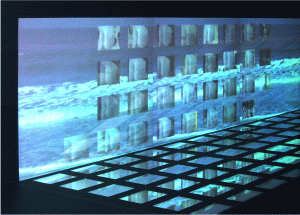« Reviews
Navjot Altaf - Lacuna in Testimony

Navjot Altaf, Lacuna in Testimony, 2003, 3 Channel Video Installation with 72 mirror pieces, Courtesy Talwar Gallery, New York and New Delhi.
Frost Art Museum, Miami
Through January 10, 2010
By Janet Batet
I have always been obsessed by the controversial ways in which memory manifests itself, keeping us away from the torrid endless suffering and the madness, and all this thanks to forgetfulness.
Gujarat, 2002- The Hindu-Muslim riots and massacres left at least a thousand dead in this industrialized state, located in northwestern India near the border with Pakistan. The starting point: the Sabamarti Express train, returning from a religious ceremony in Ayodhya -site of previous communal tensions between Hindus and Muslims- was attacked. As a result, all of its passengers -mostly women, children and seniors- were burned alive. More than 150 towns and 900 villages in at least fifteen of the state’s 25 districts were severely affected by the post-Sabamarti Express violence.
Navjot Altaf (Meerut, India, 1949) visited Ahmedabad, Gujarat’s largest city, several months later. She spent time with survivors, trying to recreate the tragic events. Then, she realized that the incomplete testimonies forgot relevant details, or the sequential order. Oblivion had been established as the only possible remedy for facing horror and sufferance.
Lacuna in Testimony is inspired by this traumatic experience. The evocative media installation comprised of three channels of video and 48 mirrors tries to portray the horrendous nature of the events by capturing the psychological block and recovering fragmented memory. On the three parallel-channel videos located on the wall, the artist projects a panoramic view of the beautiful waters of the Arabian Sea. The rhythmic and serene waves suggest to us -in their coming and going- the idea of cycle that inevitably accompanies the story.
A grid comprised of forty-eight windows overlays the magnificent and sententious sea, offering different non-narrative fragments about the riots. Altaf appropriates different media. From still to moving images that induce analogies, parallels or contrasts, the artist creates a poetic palimpsest about one of the most pressing issues of contemporary society: violence and intolerance.
The recurrence, at other violent milestones of our recent history, acts as a vital glimpse. The implosion of the Twin Towers, the destruction of one of the statues of Buddha by the Taliban and the Iraq War are some of the flashes that activate our memory making us aware of what is ultimately a global concern.
Seventy-two mirrors, arranged in strict Cartesian order, spread the narrative in a new dislocated and fragmented image. At times, we have the impression of being in a graveyard. However, even when the atmosphere is overwhelming, the beauty disarms us.
We remain astonished. The sounds of the waves, which come and go in sempiternity calm, capture our ears. Smoothly, almost without noticing it, the deep blue sea starts turning bright red, the rhythm accelerates and the testimonials become ubiquitous, all that before the magnificent Arabian Sea turns back to the appeasing blue and we start hearing children’s voices far in the distance getting closer and closer, bringing at last hope and concert.
Lacuna in Testimony is a balanced symphony between remembering and forgetting, heartache and hope, where every single resource is efficiently used as a function of the general orchestration and the relevance of the
Filed Under: Reviews


































